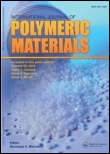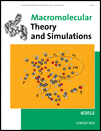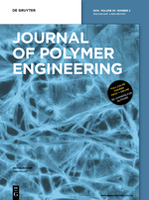
COLLOID AND POLYMER SCIENCE
Scope & Guideline
Unraveling the Dynamics of Surface Interactions
Introduction
Aims and Scopes
- Colloidal Systems and Interfaces:
Research on the behavior, stability, and interactions of colloidal particles and their interfaces, including studies on surfactants, emulsions, and suspensions. - Polymer Synthesis and Characterization:
In-depth investigations into the synthesis, modification, and characterization of polymers, focusing on their physical and chemical properties. - Nanocomposites and Hybrid Materials:
Exploration of nanocomposite materials that combine polymers with inorganic nanoparticles, emphasizing their enhanced properties for applications in various fields such as medicine, electronics, and environmental science. - Rheology and Flow Behavior:
Studies on the flow properties and rheological behavior of polymeric and colloidal systems, with implications for processing and application in industrial settings. - Biomedical Applications:
Research focused on the development of polymeric materials for drug delivery, tissue engineering, and other medical applications, highlighting biocompatibility and functionality.
Trending and Emerging
- Sustainable and Green Materials:
There is a growing emphasis on the development of environmentally friendly polymers and colloidal systems, as researchers focus on sustainable practices in material synthesis and application. - Smart and Responsive Polymers:
Research on stimuli-responsive polymers that can change their properties in response to environmental factors (e.g., pH, temperature) is increasingly popular, particularly in drug delivery and sensor applications. - Nanotechnology in Colloidal Systems:
The integration of nanotechnology into colloidal science is a significant trend, with studies focusing on the use of nanoparticles to enhance the properties of polymeric materials and improve their functionalities. - Advanced Characterization Techniques:
Emerging methods such as in situ and real-time characterization techniques are gaining traction, allowing for better understanding of the dynamics and interactions within colloidal and polymer systems. - Biomacromolecules and Biodegradable Polymers:
Research into natural polymers and their derivatives, as well as biodegradable materials, is on the rise, reflecting the increasing interest in health and environmental sustainability.
Declining or Waning
- Traditional Polymer Blends:
Research on conventional polymer blends has decreased as more innovative and functional materials, such as nanocomposites and smart polymers, gain prominence. - Basic Surfactant Studies:
Studies focusing solely on the basic properties of surfactants, without application to complex systems, have waned as researchers seek more integrated approaches involving applications in emulsions and dispersions. - Static Characterization Techniques:
There is a noticeable drop in publications centered around static characterization techniques, as dynamic and advanced methods gain preference for providing more comprehensive insights into material behaviors.
Similar Journals

ACS Applied Polymer Materials
Unveiling Breakthroughs in Material ScienceACS Applied Polymer Materials is a prestigious journal published by the American Chemical Society, specifically tailored for the dynamic fields of Organic Chemistry, Polymers and Plastics, and Process Chemistry and Technology. With its ISSN 2637-6105, the journal has rapidly established itself within the academic community, achieving a distinguished Q1 quartile ranking across multiple categories in 2023. This places it among the top-tier journals globally, reinforcing its critical role in disseminating groundbreaking research and innovation in polymer science. The journal is known for its rigorous peer-review process and publishes high-quality articles that are pivotal for researchers, professionals, and students eager to advance knowledge in polymer materials and their applications. Positioned to cover converging themes from 2019 through 2024, ACS Applied Polymer Materials embraces a wide scope of studies, from fundamental chemistry to practical engineering applications, thereby fostering significant advancements in material science. While it offers traditional access options, the journal's impact is reflected in its impressive rankings within Scopus, indicating its relevance and influence in the chemical engineering domain. Join the global community of innovators and discover the latest insights that continue to shape the landscape of applied polymer research.

International Journal of Polymeric Materials and Polymeric Biomaterials
Advancing Research in Polymeric InnovationsThe International Journal of Polymeric Materials and Polymeric Biomaterials, published by Taylor & Francis AS, stands at the forefront of materials science, showcasing groundbreaking research in the fields of Analytical Chemistry, Chemical Engineering, and Polymeric Materials. With an ISSN of 0091-4037 and an E-ISSN of 1563-535X, this esteemed journal, established in 1971, serves as a vital platform for academics and professionals seeking to disseminate innovative findings and elevate the understanding of polymeric materials. Featuring a commendable impact factor and ranking in the top quartiles of its categories—Q2 in Analytical Chemistry, Chemical Engineering, and Polymers and Plastics—the journal is a pivotal resource for researchers aiming to leverage polymer science in various applications. Although it does not offer open access, its rigorous peer-review process ensures that only high-quality research is published, making it an essential reference for anyone involved in polymer research and development.

COLLOIDS AND SURFACES A-PHYSICOCHEMICAL AND ENGINEERING ASPECTS
Navigating the Frontiers of Interdisciplinary ScienceCOLLOIDS AND SURFACES A-PHYSICOCHEMICAL AND ENGINEERING ASPECTS is a prestigious journal published by Elsevier, focusing on the interdisciplinary domains of colloid and surface chemistry, physical and theoretical chemistry, and engineering aspects. With an impressive impact factor and consistently high rankings—Q2 in Colloid and Surface Chemistry, and Q1 in both Physical and Theoretical Chemistry as well as Surfaces and Interfaces—it stands as a vital resource for researchers and professionals seeking to advance their understanding in these critical areas of study. Established in 1993, the journal spans over three decades of publication, gathering robust interdisciplinary insights that cater to both fundamental research and practical applications. While the journal is not currently open access, it remains an essential platform for disseminating innovative studies that explore the physicochemical properties of colloidal systems and surface interactions. Based in the Netherlands, the journal actively encourages contributions that enhance the scientific community’s knowledge and application of these complex phenomena, making it an indispensable tool for students and professionals alike in their quest for cutting-edge advancements.

MACROMOLECULAR THEORY AND SIMULATIONS
Transforming Simulations into Scientific BreakthroughsMACROMOLECULAR THEORY AND SIMULATIONS, published by WILEY-V C H VERLAG GMBH in Germany, serves as a crucial platform for researchers and professionals in the fields of condensed matter physics, inorganic chemistry, materials chemistry, organic chemistry, and polymer science. Since its inception in 1992, the journal has provided a valuable resource for the dissemination of innovative theoretical and simulation-based research pertaining to macromolecules. With a current ranking in the Q3 quartile across multiple categories – including a rank of #98 in Polymers and Plastics and #50 in Inorganic Chemistry as of 2023 – it offers a unique opportunity for authors to engage with a global audience. Although it does not provide open access, the journal remains dedicated to advancing knowledge and fostering scholarly communication within its diverse scientific community, thus significantly contributing to developments in material science and polymer research. As it progresses into its convergence year of 2024, MACROMOLECULAR THEORY AND SIMULATIONS continues to inspire ground-breaking studies and elevate discourse, making it an essential resource for students and established researchers alike.

Colloids and Interfaces
Innovating Connections in Surface ChemistryColloids and Interfaces is a cutting-edge open access journal published by MDPI based in Switzerland, focusing on innovative research in the fields of colloid and surface chemistry. Established in 2017, this journal has quickly become a significant platform for sharing critical insights and advancements within the discipline, maintaining a commendable impact factor that reflects its scholarly importance. With a Q2 ranking in miscellaneous chemistry and a Q3 rank in colloid and surface chemistry, it stands as a vital resource for researchers and professionals dedicated to the study of colloidal phenomena. The journal's open access policy, initiated in 2018, ensures that findings are readily available to a global audience, fostering collaboration and innovation. As it continues to converge research until 2024, Colloids and Interfaces is positioned to further enhance the burgeoning field of colloidal science.

JOURNAL OF POLYMER RESEARCH
Illuminating Innovations in Materials ChemistryJOURNAL OF POLYMER RESEARCH is a leading peer-reviewed journal published by SPRINGER, specializing in the dynamic fields of polymer science, materials chemistry, and organic chemistry. Operating since 1994, this esteemed journal has consistently delivered high-quality research articles that illuminate the latest advancements and innovations in polymer technology. With an increasing impact factor and placed in the Q2 category for both Materials Chemistry and Polymers and Plastics, it stands as a valuable resource for researchers, professionals, and students seeking cutting-edge knowledge in these areas. The journal is indexed in Scopus, highlighting its significance in the academic community, with notable rankings in Materials Science and Organic Chemistry. While it does not currently offer open access options, the meticulous selection of research and thorough peer-review process ensures each article's contribution to the field is both robust and impactful. Researchers aiming to expand their understanding and engage with pioneering studies will find JOURNAL OF POLYMER RESEARCH an indispensable platform.

E-POLYMERS
Transforming Ideas into Solutions in Polymer ScienceE-Polymers, an esteemed journal published by De Gruyter Poland Sp. z o.o., serves as a vital platform for advancing knowledge in the fields of chemical engineering, polymer science, and theoretical chemistry. With its Open Access policy since 2019, researchers from around the globe can freely access and disseminate groundbreaking findings that span the convergence of diverse disciplines, making it an indispensable resource for both academia and industry. The journal is recognized for its significant impact, reflected in its Q2 ranking in Chemical Engineering, Physical and Theoretical Chemistry, and Polymers and Plastics categories in 2023. Its impressive Scopus rankings further solidify its position, showcasing a percentile rank of 70th and above across major categories. With a publication history extending from 2001 to 2024, E-Polymers continually addresses pressing challenges within the polymer research community, fostering innovation and collaboration among researchers, professionals, and students eager to contribute to the evolving landscape of materials science.

ACS Macro Letters
Unleashing the Potential of Polymers and PlasticsACS Macro Letters, published by the American Chemical Society, is a leading journal in the fields of Inorganic Chemistry, Materials Chemistry, Organic Chemistry, and Polymers and Plastics. Established in 2012, this journal has swiftly ascended to the forefront of chemical research with an impressive reputation, as evidenced by its 2023 Scopus rankings placing it in the first quartile across multiple categories. The journal's objective is to disseminate timely and concise articles that advance the study of macromolecules and their applications, making it an essential resource for researchers, professionals, and students alike. With a focus on fostering innovation and facilitating collaboration within the chemical community, ACS Macro Letters presents a robust platform for scientists to share their groundbreaking findings. Being based in the United States, it serves as a central hub for global discourse in the chemical sciences, although it does not currently offer Open Access options. The journal's commitment to high-quality content is further underscored by its prestigious impact factor and acceptance into elite academic quartiles, signifying its influence and importance in shaping future research.

JOURNAL OF POLYMER SCIENCE
Elevating Polymer Science: Bridging Research and Real-World ApplicationsJOURNAL OF POLYMER SCIENCE, published by WILEY, is a premier, open-access journal dedicated to advancing the field of polymer science and its applications. With an ISSN of 2642-4150, it offers a platform for high-quality research and innovative ideas, contributing significantly to the understanding of polymaterials and their functionalities. The journal is recognized for its exceptional impact within various categories, consistently achieving Q1 rankings in Materials Chemistry, Physical and Theoretical Chemistry, and Polymers and Plastics, demonstrating its influential presence in the academic community. As of 2023, it holds a distinguished position in Scopus rankings, underscoring its relevance and rigorous peer-review process. By facilitating open access to vital research findings, the JOURNAL OF POLYMER SCIENCE plays a crucial role in fostering collaboration and knowledge transfer among researchers, professionals, and students, paving the way for innovative developments in polymer applications and materials science.

JOURNAL OF POLYMER ENGINEERING
Driving Technological Breakthroughs in Polymers.JOURNAL OF POLYMER ENGINEERING, published by Walter de Gruyter GmbH, stands as a pivotal platform in the field of polymer science and engineering. With an ISSN of 0334-6447 and an E-ISSN of 2191-0340, this journal has been a vital contributor to the academic landscape since its inception, spanning publications from 1981 to 2024. As a recognized entity in the realms of Chemical Engineering, Materials Chemistry, and Polymers and Plastics, it holds a respectable position in Q3 quartile rankings according to the latest assessments. The journal is positioned to promote the exchange of cutting-edge research findings, technological advancements, and critical reviews that address the complexities of polymer application and innovation. Researchers and professionals will find a wealth of information, from experimental methodologies to theoretical analyses, all designed to inspire and elevate the current understanding of polymer engineering. By fostering collaboration and dissemination of knowledge, the JOURNAL OF POLYMER ENGINEERING remains crucial for advancing research and education in its specialized domains.